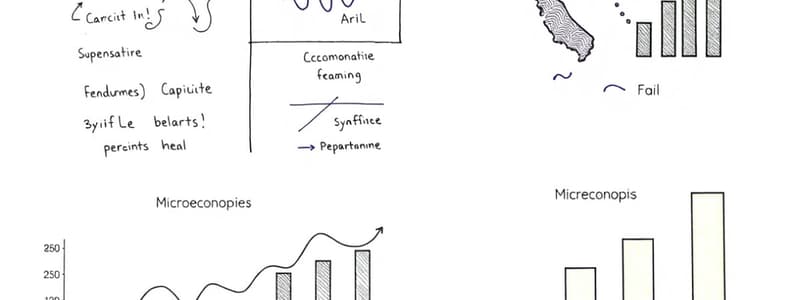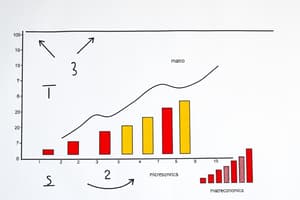Podcast
Questions and Answers
In a purely capitalist system, who primarily owns and operates companies?
In a purely capitalist system, who primarily owns and operates companies?
- The government
- Foreign investors
- Community collectives
- Private citizens (correct)
Which political system is best described as one where the government controls all aspects of life?
Which political system is best described as one where the government controls all aspects of life?
- Communism
- Socialism
- Capitalism
- Fascism (correct)
In the circular flow model, what is an example of a leakage?
In the circular flow model, what is an example of a leakage?
- Exports
- Savings (correct)
- Government spending
- Investments
What does a Production Possibilities Curve (PPC) illustrate about an economy?
What does a Production Possibilities Curve (PPC) illustrate about an economy?
What is a key difference between saving and investing?
What is a key difference between saving and investing?
A PPC curve showing a straight line indicates what about the opportunity cost of production?
A PPC curve showing a straight line indicates what about the opportunity cost of production?
What is the primary purpose of budgeting?
What is the primary purpose of budgeting?
What happens to the purchasing power of money during periods of high inflation if the real interest remains the same?
What happens to the purchasing power of money during periods of high inflation if the real interest remains the same?
Which of the following best describes the 'fallacy of composition'?
Which of the following best describes the 'fallacy of composition'?
What is the key distinction between 'productive' and 'efficient' use of resources?
What is the key distinction between 'productive' and 'efficient' use of resources?
In economics, what does the concept of 'scarcity' primarily refer to?
In economics, what does the concept of 'scarcity' primarily refer to?
Which of the following is NOT considered a 'factor of production'?
Which of the following is NOT considered a 'factor of production'?
Which economic system is characterized by a mixture of government intervention and free market activity?
Which economic system is characterized by a mixture of government intervention and free market activity?
What is the primary purpose of understanding opportunity cost in economic terms?
What is the primary purpose of understanding opportunity cost in economic terms?
Which of these resources is considered 'intangible'?
Which of these resources is considered 'intangible'?
The 'hoc post fallacy' is best described as:
The 'hoc post fallacy' is best described as:
Which savings plan is specifically designed to help individuals save for post-secondary education?
Which savings plan is specifically designed to help individuals save for post-secondary education?
What is a key factor that determines if credit is considered 'good'?
What is a key factor that determines if credit is considered 'good'?
Which of the 'Five C's of Credit' refers to a borrower's ability to repay a loan based on their current financial situation?
Which of the 'Five C's of Credit' refers to a borrower's ability to repay a loan based on their current financial situation?
In which industry would the extraction of raw materials like mining or forestry fall in?
In which industry would the extraction of raw materials like mining or forestry fall in?
Which type of business activity or service would most likely fall in the tertiary sector?
Which type of business activity or service would most likely fall in the tertiary sector?
What is the outcome of a company using a merger strategy?
What is the outcome of a company using a merger strategy?
What is the main difference between horizontal integration and vertical integration?
What is the main difference between horizontal integration and vertical integration?
Acquisition of a company most accurately refers to which one of the following statements?
Acquisition of a company most accurately refers to which one of the following statements?
Which investment type represents a loan to a company that will be repaid with interest?
Which investment type represents a loan to a company that will be repaid with interest?
Which of the following best describes 'demand' in economics?
Which of the following best describes 'demand' in economics?
Which of the following is NOT considered a non-price factor affecting demand?
Which of the following is NOT considered a non-price factor affecting demand?
What does 'quantity supplied' refer to in the context of economics?
What does 'quantity supplied' refer to in the context of economics?
Which of these is NOT a non-price factor that influences supply?
Which of these is NOT a non-price factor that influences supply?
What is meant by 'market equilibrium'?
What is meant by 'market equilibrium'?
What is the main distinction between common stock and preferred stock?
What is the main distinction between common stock and preferred stock?
What is the effect of a price set above the equilibrium price in a competitive market?
What is the effect of a price set above the equilibrium price in a competitive market?
What term describes the idea that producing more of one good results in a higher opportunity cost?
What term describes the idea that producing more of one good results in a higher opportunity cost?
Which economic concept best describes the situation when an economy does not have enough resources to satisfy everyone's wants?
Which economic concept best describes the situation when an economy does not have enough resources to satisfy everyone's wants?
Which term describes the situation where the cost per unit decreases as production volume increases?
Which term describes the situation where the cost per unit decreases as production volume increases?
Which of the following best describes an economic system characterized by private ownership and the pursuit of profit?
Which of the following best describes an economic system characterized by private ownership and the pursuit of profit?
What is the primary characteristic of a market economy?
What is the primary characteristic of a market economy?
Statements such as “the government should reduce taxes to stimulate the economy” are best described as which kind of economic statement?
Statements such as “the government should reduce taxes to stimulate the economy” are best described as which kind of economic statement?
Which of the following is an example of a capital good?
Which of the following is an example of a capital good?
What term describes the study of the economy as a whole, including inflation, unemployment, and economic growth?
What term describes the study of the economy as a whole, including inflation, unemployment, and economic growth?
The 'Fallacy of Composition' refers to what type of error in reasoning?
The 'Fallacy of Composition' refers to what type of error in reasoning?
What does the term 'ceteris paribus' mean in economic analysis?
What does the term 'ceteris paribus' mean in economic analysis?
Which of these would be considered an intangible resource?
Which of these would be considered an intangible resource?
In a command economy, who makes the primary decisions regarding production and distribution?
In a command economy, who makes the primary decisions regarding production and distribution?
According to the content, what is the point at which profits are maximized?
According to the content, what is the point at which profits are maximized?
Flashcards
Opportunity Cost
Opportunity Cost
The cost of choosing one option over another. It represents the value of the best alternative that you give up.
Scarcity
Scarcity
A situation where people's unlimited wants and needs exceed the limited resources available to satisfy them.
Factors of Production
Factors of Production
Factors of production are the resources used to produce goods and services. These include capital (machines, tools), labor (workers), land (natural resources), and entrepreneurship (the skill to combine the other factors).
Tangible Resource
Tangible Resource
Signup and view all the flashcards
Intangible Resource
Intangible Resource
Signup and view all the flashcards
Effective Use of Resources
Effective Use of Resources
Signup and view all the flashcards
Efficient Use of Resources
Efficient Use of Resources
Signup and view all the flashcards
Market Economy
Market Economy
Signup and view all the flashcards
Circular Flow Model
Circular Flow Model
Signup and view all the flashcards
PPC Curve (Production Possibilities Curve)
PPC Curve (Production Possibilities Curve)
Signup and view all the flashcards
Money's Changing Purchasing Power
Money's Changing Purchasing Power
Signup and view all the flashcards
Budgeting
Budgeting
Signup and view all the flashcards
Saving
Saving
Signup and view all the flashcards
Investing
Investing
Signup and view all the flashcards
Capitalism
Capitalism
Signup and view all the flashcards
Communism
Communism
Signup and view all the flashcards
RRSP (Registered Retirement Savings Plan)
RRSP (Registered Retirement Savings Plan)
Signup and view all the flashcards
RESP (Registered Education Savings Plan)
RESP (Registered Education Savings Plan)
Signup and view all the flashcards
Capacity (Five C's of Credit)
Capacity (Five C's of Credit)
Signup and view all the flashcards
Collateral (Five C's of Credit)
Collateral (Five C's of Credit)
Signup and view all the flashcards
Primary Industry
Primary Industry
Signup and view all the flashcards
Secondary Industry
Secondary Industry
Signup and view all the flashcards
Merger
Merger
Signup and view all the flashcards
Acquisition
Acquisition
Signup and view all the flashcards
Microeconomics
Microeconomics
Signup and view all the flashcards
Macroeconomics
Macroeconomics
Signup and view all the flashcards
Production Possibilities Curve
Production Possibilities Curve
Signup and view all the flashcards
Productivity
Productivity
Signup and view all the flashcards
Demand
Demand
Signup and view all the flashcards
Quantity Demanded
Quantity Demanded
Signup and view all the flashcards
Supply
Supply
Signup and view all the flashcards
Quantity Supplied
Quantity Supplied
Signup and view all the flashcards
Market Equilibrium
Market Equilibrium
Signup and view all the flashcards
Economic Profit
Economic Profit
Signup and view all the flashcards
Equilibrium Point
Equilibrium Point
Signup and view all the flashcards
Non-Price Factors of Demand (CAPIT)
Non-Price Factors of Demand (CAPIT)
Signup and view all the flashcards
Capital Goods
Capital Goods
Signup and view all the flashcards
Consumer Goods
Consumer Goods
Signup and view all the flashcards
Ceteris Paribus
Ceteris Paribus
Signup and view all the flashcards
Constant Opportunity Costs
Constant Opportunity Costs
Signup and view all the flashcards
Economics
Economics
Signup and view all the flashcards
Economic System
Economic System
Signup and view all the flashcards
Command Economy
Command Economy
Signup and view all the flashcards
Study Notes
Examination Structure
- Examination is divided into four parts.
- Part A: Knowledge (Multiple Choice), 25 marks, 25 minutes.
- Part B: Thinking (Short Answer & Charts/Diagrams), 22 marks, 30 minutes.
- Part C: Application (Modelling and Interpreting Models), 26 marks, 35 minutes.
- Part D: Communication (Short Answers - Choose 2 out of 4 options), 12 marks, 20 minutes.
- Review your Answers, 10 minutes.
- Total Marks: 85.
Introduction to Economics
- Economics is a social science that studies human behaviour, specifically regarding decisions about needs and wants.
- The fundamental economic problem is scarcity — limited resources cannot fulfill unlimited wants.
- Microeconomics examines individual choices, businesses, and consumers.
- Macroeconomics examines the economy as a whole.
Economic Thinking and Decision-Making
- Economists consider cause-and-consequence relationships (positive/negative, direct/indirect, local/global, short-term/long-term, intended/unintended, instant/delayed, foreseeable/unforeseeable)
- A rational choice involves a benefit that outweighs the cost.
- Utility is the benefit or satisfaction derived from consuming something.
- Positive economics involves factual statements, and normative economics involves opinions.
- The ceteris paribus assumption assumes all other factors remain constant.
- Common fallacies include the fallacy of composition, post hoc fallacy, and the fallacy of single causation.
Fundamental Economic Questions
- Key economic questions include what to produce, how to produce it, and who gets the resources.
- Factors of production include land, labour, capital, and entrepreneurship.
- Tangible resources are physical assets, while intangible resources are non-physical assets (e.g. knowledge, brand reputation).
- Effective use of resources involves achieving the task.
- Efficient use of resources involves doing the task in a better way.
Economic and Political Systems
- Economic systems include traditional, market, command, and mixed economies.
- Political systems include capitalism (citizens own and run companies), communism (government owns and distributes resources), fascism (government controls everything), and socialism (cooperation to equally provide for all).
- Understand the characteristics of different economic and political systems.
Use of Economic Models
- Circular Flow Diagram describes a simple economy's flow of goods, services, and money.
- Production Possibilities Curve (PPC) illustrates an economy's production possibilities and concept of opportunity costs.
- PPC indicates whether production is efficient or inefficient.
- PPC illustrates if production is attainable or unattainable.
- Concepts such as constant opportunity cost, law of diminishing returns, and law of increasing returns to scale are relevant to the shape of a PPC.
Business Organizations and Finance
- Income management involves understanding money value and budgeting.
- Saving and investing involves comparing and contrasting savings and investment options.
- Banking involves credit cards, creditworthiness, and five Cs of credit (character, capacity, capital, conditions, collateral).
- Types of industries include primary (extraction), secondary (manufacturing), and tertiary (services).
Forms of Business Ownership
- Understand different forms of business ownership (characteristics and advantages/disadvantages).
- Includes ways a business can expand (mergers, acquisitions, alliances).
- Common forms of investments include common and preferred stock, and bonds.
Microeconomics
- Demand relates to quantity demanded and price in relation to shifts.
- Supply relates to quantity supplied and price in relation to shifts.
- Equilibrium is when supply and demand meet.
- Market structures include perfect competition, monopolistic competition, oligopoly, and monopoly.
Studying That Suits You
Use AI to generate personalized quizzes and flashcards to suit your learning preferences.




